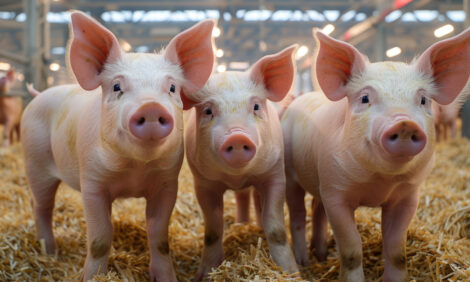



Heat Stress Reduces Performance
By Kayt Johnson, BPEX Knowledge Transfer Manager - This report is part of a series of articles offering top tips for hot weather from BPEX's Knowledge Transfer.- If the boars are heat-stressed fertility will be reduced for up to 8 weeks
- If number born is down by one pig per litter, you will lose £25/sow/year
- If growth rate cut by 50 g/d, = +1 week to slaughter, you will lose £1/pig
You can reduce heat stress by applying the WWWS rules:
- WATER - Ensure adequate supply of cool water at all times to all pigs
- Are all drinkers working?
- Is flow rate adequate?
- If in doubt supply additional water in troughs, keep topped up
- WIND – Maximise air flow
- Check and clean existing fans,
- Add fans and open doors
- WETTING - Pigs can’t sweat but can keep cool if their skin is damp
- Allow older pigs access to wet concrete if possible
- or provide small amounts of water over neck and back, repeat every 1-2 h (particularly for boars, lactating sows and sows in late pregnancy)
- Wallows for outdoor animals
- SHADE - Provide shade
Breeding Herd – apply WWWS, plus:
- Serve at either end of the day where possible
- If AI is outdoors ensure that the holding areas are covered
- Use young, virile ‘V’ boars in pairs or threes for maximum stimulation
- Temperature control of AI doses is vital, they can overheat very quickly
- Maintain hygiene of sows especially where they have been wallowing, ensure clean vulvas pre-insemination. Have hand washing facilities and / or gloves
- Keep boars cool
- Heat stressed boars have reduced fertility now and in 6 to 8 weeks time
- Mark this period on your calendar and remember to check semen quality
- If using a high level of natural service you might top up with AI don’t rely on NS.
- If using DIY AI boars check semen quality carefully.
During Lactation– apply WWWS, plus:
- Feed twice a day if not already
- Feed the larger meal at night
- Check the trough hygiene, feed can become stale rapidly.
- Check water availability and flow rate at peak demand - 2 litres/minute for lactating sows.
- Put water in feed trough.
- Control supplementary heating in farrowing, use only where necessary for the young/small pigs according to the housing environment.
- Use dimmers if you have them
- Cover the creep areas to keep the sow as cool as possible.
- Cool sows by wetting with small amount of water to neck but make sure piglets do not get chilled.
Dry sows – outdoors – apply WWWS, plus:
- Dry sows are especially vulnerable up to 2 weeks post service
- Check arc insulation – sows lying outside are a sure sign that the insulation has deteriorated.
Dry sows – Indoors – apply WWWS, plus:
- Use less straw, make wet concrete area available if possible
Growers/finishers – apply WWWS, plus:
- Check the water flow rate and quality 1 litre per minute for 30kg pig 1.5 for 70kgs.
- Reduce the stocking density where possible so that pigs are able to lie away from each other.
- Check thermostats
- Use foggers or misters if necessary
- Check that the food is fresh –feed will become stale very quickly, consider ordering less feed more frequently particularly if bulk bins are exposed to direct sunlight








